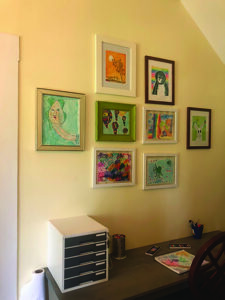
A child’s artwork brings so much joy into a home. But after it arrives, it’s up to you to decide how to display it, store it or share it. (Photo by Leslie Milby)
It’s almost time to send the kids back to school. Sure, you’ll miss them but few things beat hearing the stories they come home with, even if you only get a few clues to piece it all together. (Fingers crossed the teacher doesn’t call to fill you in on what you didn’t hear about!)
Even if you don’t get all the details of their 7 hours away from home, what you will get for sure – besides lunchbox scraps and papers to sign is their artwork. All of the artwork.
Truly, nothing beats seeing those first projects with a handprint or a sketch of you, a little oddly shaped in purple with your child under a giant rainbow.
And while the enjoyment of seeing your child’s artwork doesn’t get old, it doesn’t take long to figure, especially if you factor in more than one child, that you could probably wallpaper your entire downstairs by the end of a school year.
Before it stacks up too high, find a way to savor the masterpiece and then store it neatly if you choose to.
Before you even think about storing or displaying these great works, you’ve got to sort them.
A solid strategy, especially if you are new to the school years and hold the “every piece is a masterpiece” mentality, is to have a designated pile for it that’s near where you reset your backpacks for the next day. A kitchen drawer, a bin in your mudroom, a drawer in your desk.
And then just leave that pile there. Give it a few weeks or even a month or two.
This pile up strategy has a few perks. You know immediately what to do with it everyday when new art comes home and you’ll be able to produce it if the little artist asks in the next few days.
But best of all, in a few weeks, you can more quickly sort it and won’t be quite as attached as if it is brand new.
You’ll also notice that many times kids will settle on drawing one particular thing, be it a unicorn or a hockey rink for months and bring home some very similar pieces. By letting art stack up, you can more easily see that you have multiples and pick your favorite version of it, maybe the draft where they’ve included all their siblings instead of just one.
Keep a few aside if you’ve decided to do a display and keep a pile for gifting. With these kiddos churning out piece after piece, send a few pieces over to grandma and grandpa or mail a piece or two to your bachelor brother whose refrigerator may be barren. Artwork does bring a smile to a face, especially to those who aren’t as inundated with it.
This is even a step your child can participate in, especially if you dabble in random acts of kindness.
During this sorting stage, or even in the piling stage, if your kids are close together in age or may not always write their names, label the artwork.
Chances are, the same torn paper ladybug will repeat through all your kids as they move up the grades.
You want to clearly label so when that child gets married, you can give their new spouse all of their artwork to store in their own home.
With the piles whittled down, it’s time for storing and this too will come down to how sentimental you are. And there’s nothing wrong with honestly feeling like you can’t bear to part with a piece the same as there’s nothing wrong with keeping only three pieces from the whole year.
There are multiple ways to store the artwork depending on quantity and quality of the solution you are looking for.
The tried-and-true plastic tub stored in a dry place is still an option- you can fit a ton in there, artwork stays relatively flat, and you’ve easily created a system. Pile, sort, store and done.
More recent developments can be found online or in box stores, as product developers know a mom drowning in artwork will come looking for a solution! One such easy store solution is a thin but sturdy plastic art storage bag.
These are usually oversize to fit more mature art and a bit less kiddish too that will work well for middle school right into college. You’ll also find accordion type folders that are a bit oversize, but these can fill up pretty quickly and aren’t quite as easy to easily flip through the pieces.
If you don’t foresee yourself flipping through often and will likely only be keeping a handful of items per year, it could be the perfect system for you as you can label each tab for the grade and get quite a few years organized in a non-bulky way.
When you stick in each year’s new pieces, take the time to flip through prior years. You felt this stuff is important enough to save – so look through and enjoy it! On the other hand, you can purge more pieces that have lost their luster.
Now, no matter how ruthless you are on cutting back, those itty-bitty handprints cut into flowers, butterflies, carrots, and whatever else these teachers think of next, tug on pretty much anyone’s heart strings.
For the super-delicate pieces, consider laminating or creating a sturdier copy by scanning onto a full sheet of paper to keep those memories from getting ripped before you store them.
Holiday art deserves a category in itself. Since the holidays tend to be laced with tradition and fondness of looking back, you may choose to keep a small folder or portfolio with your Christmas, Easter, Valentines or other holiday decor to pack accompanying art in so you can pull a few pieces to display each year. While many things change, you might be surprised that your kid’s class is making the exact same beaded candy cane ornament you did decades ago and they can all be fun to pick through year after year.
Digitizing and creating a portfolio book can condense the collection even further.
To digitize, scanning is often a good option, but many prefer photographing pieces, especially if they are oversized or abnormally shaped. And really, this doesn’t even have to be done with a sophisticated camera – a smart phone works well, especially in a bright, sunny area taken from overhead.
So yes, this project probably involves mom standing on top of a sturdy chair for a solid morning to preserve priceless memories.
It’s what we do. As you digitize them, title each piece, tag it with the artist’s initials and save them into a folder for each year.
From here if you choose to, use your favorite photo company like Snapfish or Shutterfly to create a picture book. This can be a great use for the free book promo codes they often give out.
There are of course services aimed at saving our children’s artwork, too.
Many of these services provide a box to mail in the pile of artwork which they will scan or photograph for you and then send a completed project back to you, like Artkive which specializes in artbooks and mosaic pieces or Plum Print that caters to more than just artwork with specialty heirloom items.
If you kept a few favorites to the side to display, set up an easy system for that too. If you have some blank wall space, use a few frames to create a gallery. Go all matching or a mix and match to create a statement piece for your wall. If your older child often comes home with the oversized, 24-inch pieces, plan ahead on your gallery wall with a frame or two that size.
While shopping for new frames, you may notice hinged frames designed for constant changeouts, where the backing would be attached firmly to the wall and the front of the frame swings open.
These might be a good investment if your child is older and can switch things out themselves, or if you really do foresee yourself curating a home art gallery on a consistent basis.
Another quick-change option for a gallery is simply installing a finished board with nice looking clips that is spaced to hold art in an uncluttered way.
This won’t protect your art to the extent that a frame might, especially if in an exposed sunny spot, but is an option to easily and temporarily enjoy it.
A child’s artwork does bring so much joy. Joy when your child creates it and joy when you get to see it for the first time. But from there, it’s up to you to decide if it continues to “spark joy” and is worth displaying or storing, or if you’d like to simply keep your favorites.




